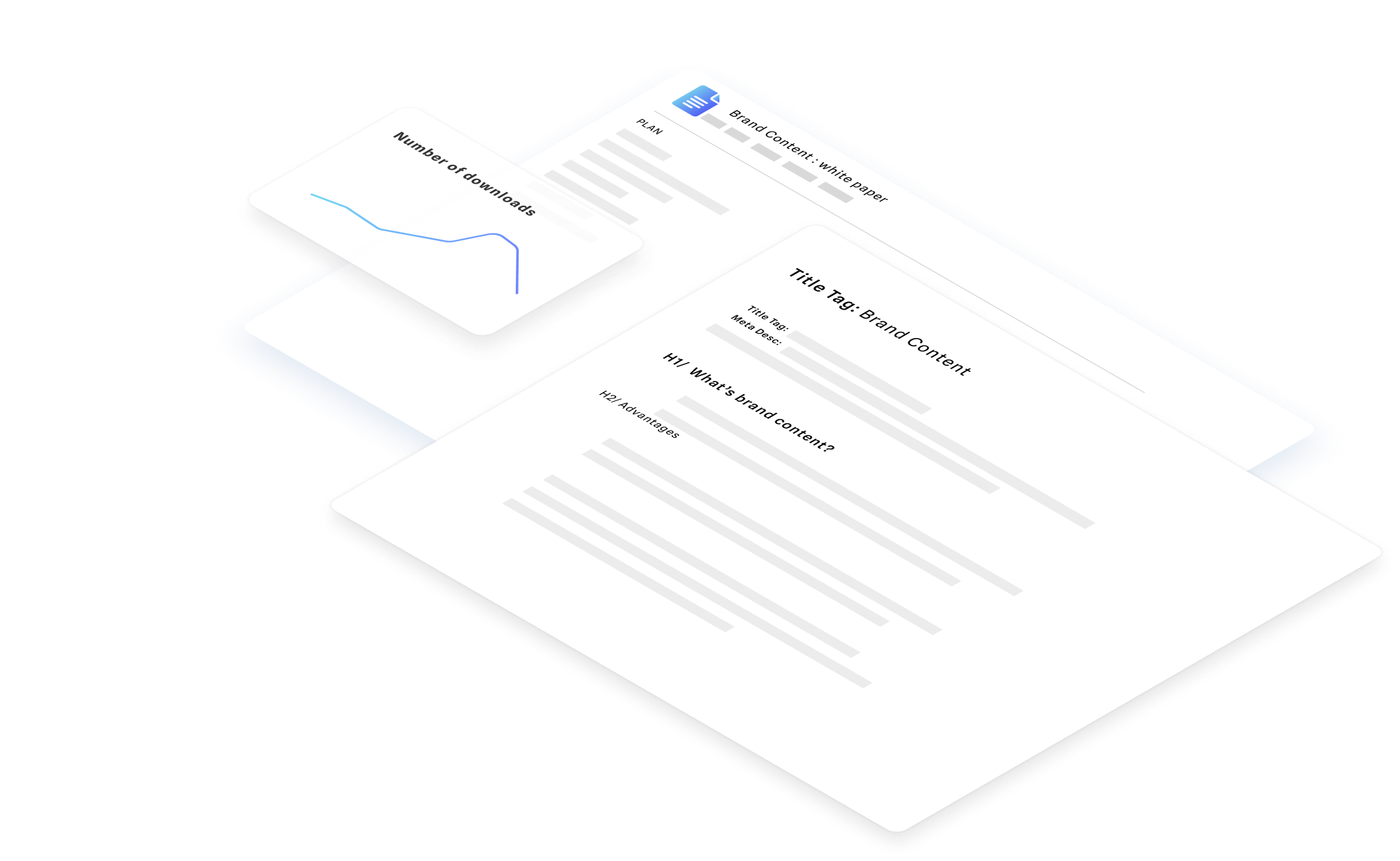
White Paper:
The Ultimate Guide
A white paper allows you to target specific audiences and generate qualified contacts. However, it follows strict rules of design and writing.

Why should you write a white paper?
What is the purpose of a white paper?
For discerning audiences who enjoy delving deep into a subject, a white paper is one of the most relevant content formats available. This textual document is known for its extensive length, ranging from 5 to 50 pages, far exceeding the typical blog articles and other content regularly published as part of a content marketing strategy. A white paper also stands out for its ability to thoroughly address a topic. For businesses, it serves as an ideal tool to demonstrate their expertise, attract the attention of highly targeted audiences, and generate qualified prospects. In an era where the internet is inundated with all kinds of content of varying quality, a white paper also plays a significant role in setting businesses apart from the competition.
Who benefits from the “White paper” format?
Originally, white papers were primarily used by government agencies, NGOs, think tanks, and financial institutions to communicate their work in a concise and accessible manner. However, with the rapid rise of content marketing, its use has become widespread across various industries. It has become common practice to write a white paper to showcase products/services or share updates. Although it is predominantly used in the B2B context, where marketers rely on detailed and comprehensive content to attract professional audiences, shorter and impactful content tends to resonate better with B2C audiences. This difference can be attributed to the longer, more complex decision-making process in B2B, where white papers serve as crucial milestones in the consideration undertaken by procurement managers.


What are the different types of white paper?

-
Type 1
The practical guide
The “guide” format lets you address common challenges faced by your target audiences and present innovative solutions. These guides tend to be longer and provide in-depth descriptions of products/services or solutions. They are typically written in an accessible yet scholarly style, often incorporating practical demonstrations. Objectives: educate your audiences, enhance your company’s reputation, and generate qualified leads.
-
Type 2
The technical document
This type of white paper focuses on the technical aspects of a product or service, offering precise and concrete details. While it may be less accessible to the general public, it effectively engages a more knowledgeable audience by surpassing the usual marketing discourse and addressing specific issues. Objectives: demonstrate your expertise, establish yourself as a leader in a specific area, and support the launch of a product/service.
-
Type 3
The list format
This type of white paper takes the form of a numbered list, providing questions and answers, tips, tricks, or best practices on a specific topic. It is specifically designed to cater to targeted audiences, such as a department within a company. What sets this format apart is its educational approach and light-hearted tone, making it more accessible and shareable. However, this doesn’t hinder its ability to convey innovative ideas and elicit reactions. Objectives: attract the attention of your target audiences, guide your prospects through a lengthy and intricate purchasing journey, and gain a competitive edge.
-
55%
of B2B marketers
use white papers to communicate with their target audiences. -
71%
of B2B buyers
refer to white papers before making their decisions. -
75%
of B2B buyers
are willing to provide company information in exchange for downloading a white paper.
What results can you expect from distributing a white paper?
White Paper: The ultimate BOFU content
BOFU stands for “Bottom-of-Funnel,” representing the final stage of the sales funnel: the conversion stage. In a content marketing strategy, different types of content are tailored to specific stages of this funnel, and the white paper proves to be particularly effective when it comes to nudging prospects towards becoming customers. This is because its format is designed to offer concrete, precise, and personalised answers to key issues faced by targeted audiences, delivered in an authoritative tone. In essence, the white paper serves as definitive proof of expertise and competence, acting as the ultimate tool for influencing undecided individuals to make a purchase. This amplifies the benefits of distributing it for the company.
The benefits of distributing a white paper

-
BENEFIT 1
Generating qualified leads
This is the primary benefit: the combination of education and persuasion makes the white paper one of the most powerful lead-generation tools in the world of marketing. Furthermore, these leads are qualified, as a user who downloads your white paper has already shown interest in the solutions you can provide. All that’s left is to convert them into customers.
-
BENEFIT 2
Developing brand image
By showcasing your expertise and positioning your company as a leading player in the market, a white paper helps develop your brand image and disseminate it to a wider audience. The result is increased brand awareness, an indisputable expert profile, and prospects drawn to your positive reputation.
-
BENEFIT 3
Building trust
The white paper instils trust by showcasing the company’s expertise, encouraging the target audience to perceive it as the go-to authority for addressing specific issues. The educational nature of this format (even in its technical version, when consumed by knowledgeable individuals) serves as a trust-building factor, bridging the gap between the white paper’s author and its readers.
-
BENEFIT 4
Supporting sales teams
Sales representatives often face numerous challenges in their interactions, including product/service misunderstandings, difficulties in grasping the benefits, or lack of familiarity with the brand. The “white paper” format is perfectly tailored to support their efforts. This tool provides a solid educational and technical foundation, presenting solutions and serving as a valuable resource to distribute during client meetings or trade shows. From a corporate perspective, it also serves as a catalyst for sales teams’ professional growth.
-
BENEFIT 5
Building a mailing list
A white paper is typically the kind of premium content that entices prospects to share their personal information in exchange for a free download. It offers an efficient and swift method to obtain e-mail addresses to expand your mailing list and encourage readers to subscribe to your newsletter. However, it is crucial that the content genuinely resonates with their interests and needs.
How many steps are involved in writing a white paper?
The white paper: a highly structured format
The white paper is a highly specific content format that caters to precise needs and offers tangible benefits. As a result, its creation is carefully structured and requires following a set of essential steps for success. Ideally, this process should involve all relevant stakeholders who can contribute to the project: marketers, experts, relevant departments, senior management, graphic designers, and more. Remember, it’s not promotional material but rather content intended to provide valuable information and/or specific answers to your audience. Therefore, it is crucial to carefully craft the language and formulation, ensuring that it speaks the same language as the targeted readers.

The 9 steps to writing a white paper

-
STEP 1
Define objectives
A white paper can serve various purposes, such as positioning your company as a leader, demonstrating expertise, attracting audience attention, or generating leads. Your content should align with the specific objectives you have set.
-
STEP 2
Identify your target audience
Identify the ideal readers you want to reach with your white paper. Choose from your buyer personas and determine at which stage of the buying cycle your typical audience is, in order to provide them with relevant and valuable content.
-
STEP 3
Select a topic
Select a topic that addresses the needs and challenges of your target audience. Consider the issues your personas face and choose a topic that you are highly knowledgeable about.
-
STEP 4
Create an outline
Develop a detailed outline that includes a working title, a concise summary of the content, a compelling introduction, the main sections and subsections to cover, and a preliminary conclusion.
-
STEP 5
Conduct research
A white paper is characterised by the quality and accuracy of its information. Conduct thorough research, involve experienced experts, and ensure the validity of your sources.
-
STEP 6
Write the content
Using your outline as a guide, dive into writing the white paper, expanding on the main sections and subsections. Remember that the writing style should be more polished and literary compared to a blog article.
-
STEP 7
Review and edit
After letting the draft rest, it’s time for the crucial phase of reviewing and editing. Make sure you eliminate any errors or mistakes, and involve relevant colleagues and experts for their input.
-
STEP 8
Dress up the content
Once the content is complete, it’s time to “dress it up” visually by formatting and aligning it with your initial vision. If you’re working with a graphic designer, provide them with a design brief to guide their work.
-
STEP 9
Finalise the document
The white paper is now ready for the final steps. Convert it into the desired format, such as a PDF, and give it a thorough proofread. You should also consider creating printed versions if needed.
Good to know
According to 96% of B2B buyers, a white paper should ideally be no longer than 10 pages. While there isn’t an exact length requirement, it’s generally advisable to keep it reasonable, aiming for a word count between 3,000 and 5,000 words.
How to effectively promote your white paper
Promoting your white paper: an extra challenge
Due to its unique characteristics, promoting a white paper can be challenging. Its specialised content requires precise targeting, and its longer length makes it unsuitable for publishing in one piece on a professional blog or social media. Moreover, its writing style, which is more formal and detached from typical web content conventions, makes it less search engine-friendly and harder to discover through online searches. Therefore, active promotion is crucial, involving direct outreach to your target audiences and offering it as a downloadable resource through a relevant landing page.
5 effective strategies for promoting your white paper

-
1
Create a dedicated landing page
A well-designed landing page with a concise overview of your white paper, a compelling call-to-action button, and a convenient download link are the essentials for enticing your audience to explore and engage with your content. Embed this landing page on your professional website, and consider promoting it through search engine optimisation or sharing it on relevant social media platforms.
-
2
Implement targeted e-mail campaigns
E-mail marketing remains a highly effective channel, with 59% of marketers recognising its superior return on investment. Leverage the power of targeted e-mail campaigns to reach your intended audience directly. Create personalised messages that highlight the value and relevance of your white paper, ensuring it reaches the right readers.
-
3
Collaborate with influencers
Influencers have emerged as invaluable allies for businesses and brands across social media platforms. Partnering with relevant influencers in your industry allows you to tap into their established communities and amplify the visibility of your white paper. Choose influencers whose expertise aligns with your content and leverage their reach to expand your audience.
-
4
Release your white paper in installments
Rather than overwhelming your readers with a lengthy white paper, consider releasing it in a serialised format. Break down the content into digestible sections and publish them periodically. This approach creates anticipation, engages your audience over time, and encourages them to download the complete document from your dedicated landing page.
-
5
Leverage digital advertising
Digital advertising presents valuable opportunities for targeted promotion. Take advantage of platforms such as Google Ads, display banners, and sponsored social media posts to raise awareness about your white paper. Ensure your advertising aligns with your target audience and directs them to the compelling landing page you’ve created.
-
69%
of white paper readers
seek information about the product/service or the seller. -
42%
of B2B buyers
use white papers to substantiate purchasing decisions to their superiors. -
33%
of B2C buyers
compile lists of competent sellers based on white papers.
Examples of Successful White Papers
What makes a white paper successful?
A white paper is one of the most effective content formats, especially in the B2B realm. It serves as a valuable tool for showcasing expertise, establishing market leadership, and demonstrating the relevance of a specific solution (product or service) in addressing specific challenges. However, creating a successful white paper can be a delicate balance – it shouldn’t be too simplistic or uninteresting for the target audience, nor should it become overly technical and difficult to comprehend. To give you an idea, we have curated four inspiring and successful white paper examples that have achieved their intended objectives.
Our Commitment
-
Expertise
Since 2010, we have worked with over 2000 clients across 90 countries.
-
Passion
We are a team of passionate, industry-focused individuals who are committed to your success.
-
Performance
We’re committed to implementing a data-driven strategy, making a real impact on your bottom line by providing avenues for growth.
Any questions?
A white paper is a content format known for its in-depth exploration of a specific topic and its length, typically ranging from 3,000 to 5,000 words. It serves as a powerful conversion tool, particularly effective in B2B marketing at the later stages of the sales funnel.
Writing a white paper involves following several key steps. First, you need to prepare by defining your objectives, identifying your target audience, and selecting a topic. Then, you proceed with the content creation phase, which includes creating a detailed outline, conducting thorough research, and writing the paper itself. Finally, you finalise the white paper by proofreading, formatting, and editing it.
To effectively promote a white paper, you need to use the right channels. This includes creating a dedicated landing page with a compelling call-to-action and a download link, targeting specific audiences through e-mail campaigns, harnessing the power of social media by collaborating with influencers, sharing enticing excerpts on your blog, and utilising digital advertising strategies.












